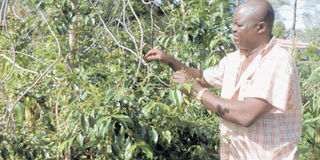Forget Meru, I grow miraa in Homa Bay

Tom Sikah in his miraa farm in Homa Bay. He is the only farmer growing the crop in the county. PHOTO | BARACK ODUOR | NATION MEDIA GROUP
About a kilometre from Ringa Trading Centre in Kabondo Kasipul, Homa Bay County, there is a farm with lush green ‘unique’ trees that turn heads.
The farm which belongs to Tom Sikah, a 50-year-old father of three, hosts miraa.
Sikah has turned his farm into the home of the crop that is mainly grown in Nyambene, Meru.
‘‘In 2008, I visited my friend Muthaura in Meru. When I saw his miraa farm, I fell in love with the crop and vowed to grow it in Kabondo because the two areas share similar weather and climatic conditions,” he recounts.
In both areas, farmers grow bananas, tea and even coffee.
His curiosity made him buy 60 miraa cuttings from Muthaura at Sh200 each.
The crop is planted from cuttings measuring about 20cm and requires temperatures ranging from 5 to 35 degrees Celsius with loamy free-draining soil. Excess water makes it drop leaves and die prematurely.
Back home, Sikah planted the cuttings on half-an-acre, part of his five-acre farm.
Not sure how to take care of the crop, the farmer left it to grow on its own as he concentrated on his work at Kenya Pipeline in Nairobi.
‘‘But even as the miraa grew, I never stopped cultivating potatoes and bananas, which are traditionally grown here,’’ says Sikah.
By 2010, the crop which matures in about five years was growing bushy, forcing him to hire the services of a farmer from Meru to train him on how to take care of it.
“The lessons involved pruning, harvesting and fertiliser application, among other things. I also learned how take care of the crop both during the dry and rainy season.’’
Sikah later employed two workers and trained them on how to tend to the crop.
“I started harvesting the fruits of my labour in 2012, where every month I would harvest the crop and sell to traders who visited my farm earning up to Sh35,000 a month.”
The good returns made him expand his miraa farm to one-and-half-acres, adding 80 more seedlings, which he again sourced from Meru.
Today, Sikah rakes in at least Sh50,000 a month from his one-and half-acre miraa farm as demands for the stimulant soars in Kendu Bay, Migori, Oyugis and even Kisii, where traders he sells the produce take.
A kilo of miraa goes at Sh2,000 with the juicier ‘kangeta’, the crop’s long bud which is deemed tastier, going for Sh6,000.
‘‘Demand is higher during the dry season because the crop needs adequate rainfall for growth. A wise farmer should invest in irrigation during the season,” explains Sikah, noting miraa is harvested using shears as one distinguishes the harvest as kangeta, asili or giza according to the sizes and lengths of the suckers or buds.
Harvesting of miraa is usually done in the morning and he does it after every two weeks with the help of his two workers, who also take care of the crop when he is away.
Having seen the potential of the business, Sikah has been approached by two friends, one from Meru and another from Kakamega to let them lease the farm.
However, the farmer says he declined the offers because his business is growing.
“Damand is good because there is little competition. Little miraa comes from Meru to these sides, which makes the business outlook good,” says Sikah, adding that farmers should invest in farm tours to learn what others are doing.
Homa Bay County Chief Officer for Agriculture, Livestock and Fisheries Jennifer Polo terms Sikah’s venture as a success story on diversity.
‘‘Sikah has done well in demonstrating that miraa can do well in Homa Bay County, the department will liaise with him to encourage other farmers to see miraa as an alternative crop that can change their lives,” said Polo, noting the fact that miraa requires little maintenance makes it a profitable venture.
Sikah plans to grow miraa on his entire five-acre farm but he decries the poor state of roads in Kabondo, which hinder traders from reaching his farm during rainy seasons.




